In this article:
Setting Up Basic Properties and Parameters of Step Description
Setting Up Links between Data Entry Form/Report and Process Parameters
Creating the Approval Step
To create an approval step of the specific data set:
In the web application:
Select the process stage or stage step and select the
 Approval step in the drop-down menu of the
Approval step in the drop-down menu of the  Data Entry button. The step selection button looks like the last selected step.
Data Entry button. The step selection button looks like the last selected step.Select the Approval step in the working area and click the
 Settings button on the toolbar. The Approval parameters panel opens to set up the step.
Settings button on the toolbar. The Approval parameters panel opens to set up the step.In the desktop application open the approval step wizard.
Setup of the Approval step includes the following operations:
Setting Up Basic Properties and Parameters of Step Description
Determine basic step properties and also step description parameters:
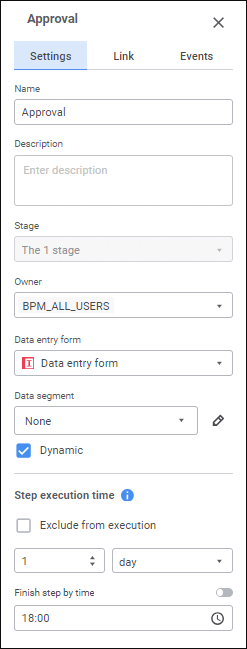
Set the following parameters on the parameters for the Approval step on the Settings tab after determining basic step properties:
Write Permission in Step. Select the checkbox to grant a dynamic permission to read and write to a data segment for the user or the group of users specified in the User drop-down list. The selected users should be contained in the authorization object specified in the Authorization Object drop-down list. The dynamic permission works only during step execution. Selecting users in the User drop-down list is available only if the checkbox is selected.
NOTE. The parameter is displayed if the Authorization Objects radio button is selected on process parameters setup.
Data Entry Form. The box is mandatory. In the drop-down list select a data entry form or report, which will store step execution/rejection result. The list contains repository objects tree where data entry forms, regular reports, and folders containing them are only displayed. To quickly search for objects, use the search string.
Data Segment. In the drop-down list select one or several cube data segments used as a data source in the selected data entry form, to separate access permissions for users or groups of users to data slices on process startup. To add data segments, use the cube data segment wizard. To set up interaction between the process and cube data segments, use the Segment Settings dialog box.
To determine a segment management method, use the Dynamic checkbox.
NOTE. The parameter is displayed if the Data Segments radio button is selected on process parameters setup.
Authorization Object. The box is mandatory. It is used to support the processes that use existing authorization objects created in the desktop application. In the web application, it is recommended to use data segments to separate security subject access permissions.
NOTE. The parameter is displayed if the Authorization Objects radio button is selected on process parameters setup. To ensure correct work of business processes in the data entry form, dimension selection of authorization object shoudl be fully contained in the selection by dimensions of data entry form that is used in the process step.

Set the following parameters on the Step Description page for the Approval step after determining basic step properties:
Process Authorization Object. The box is mandatory. Select the required object in the process authorization objects drop-down list.
If there is no appropriate authorization object, click the All Process Authorization Objects button. The Set Up Process Authorization Objects dialog box opens where an authorization object can be added.
NOTE. To provide correct work of business processes in a data entry form, selection by dimensions of the authorization object should be fully contained in the selection by dimensions of data entry form that is used in the process step.
Owner Role. The box is mandatory. In the drop-down list select the user or the group of users responsible for step execution on process execution. The list contains users specified in the authorization object.
If the list does not contain the required group of users, click the Open Security Manager button. The dialog box of security manager of Foresight Analytics Platform opens, which enables the user to create the required group of users.
By default, the selected user has read-only permission.
Grant Write Permission Within Step. Select the Grant Write Permission Within Step checkbox to grant dynamic write permission to data segment to a group or a user specified in the Owner Role list. Dynamic permission is applied only on step execution.
When the checkbox is deselected, group or user will have read-only permission.
Send Edit Permissions. Select the Send Edit Permissions checkbox and select the group or user in the list to assign read and write permissions to data segment. When this checkbox is selected, the group or user selected in the Owner Role box get read-only permissions.
The checkbox is deselected by default. To enable the option, select the Grant Write Permission Within Step checkbox.
Data Entry Form. The box is mandatory. Select data entry forms and/or regular reports, in which the step execution/rejection result will be saved. The list contains repository objects tree where data entry forms, regular reports, and folders containing them are only displayed. When selecting a data entry form or a report, you can use search.
If data entry forms, which use data from the same authorization object, are selected to save step execution/rejection result, any of the selected forms will allows for data entry and approval. To correctly execute the step and display process tree in data entry form – selection by dimensions of data entry form should fully contain selection by dimensions of authorization object that is used in process step.
If regular reports are selected to save step execution/rejection result, step management is available only in process monitoring.
Default Data Entry Form. When several data entry forms or regular reports are selected, in the drop-down list specify a default data entry form or report. A default data entry form or report will open on process step execution. To edit the a default data entry form or report, click the
 Edit button. The data entry form or report will open for edit.
Edit button. The data entry form or report will open for edit.
Step Execution Time. Specify the time, in which a step should be executed on process execution. Execution time is counted from step activation.
Enter a numeric value of step execution time and select a time measurement unit in the list: minute, hour, day (default), week, month, quarter, half-year, or year.
To determine time, by which step must be finished, select the Finish Step By checkbox. When the Minute or Hour measurement units are selected, this box is hidden.
If the step is not finished by the scheduled execution period, the step status becomes Expired.
The step execution period impacts the whole process execution period, which is determined during process start.
Step Description. The box is optional. A text box for entering a comment for a step.
After the parameters have been determined on the Step Description page, click the Next button.
Setting Up Links between Data Entry Form/Report and Process Parameters
Set a link between data entry form or regular report and process parameters to open data entry form or report with the same parameters as the started process step.:
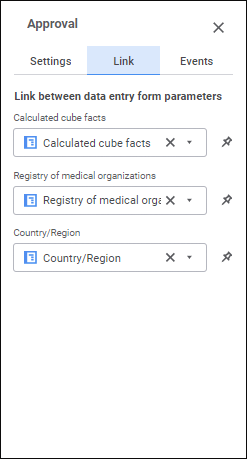
NOTE. If data entry form or report does not contain parameters, the list is displayed as empty.
On the parameters panel, for the Approval step, on the Link tab for each static field, which displays data entry form or report parameter name, select the corresponding process parameter name in the drop-down list. If the parameter is not selected, the data entry form or report opens with the parameter value specified in the default data entry form or report.
To limit the number of parameter values, with which the data entry form or report is started, execute the following operations:
Click the
 Fix Data Entry Form Parameter Values button. The drop-down list displays elements of data entry form or report parameter dictionary.
Fix Data Entry Form Parameter Values button. The drop-down list displays elements of data entry form or report parameter dictionary. Select parameter value of the data entry form or report linked to process step. Multiple selection is available.
If a parameter value is is not selected, selection is absent in the data entry form or report.
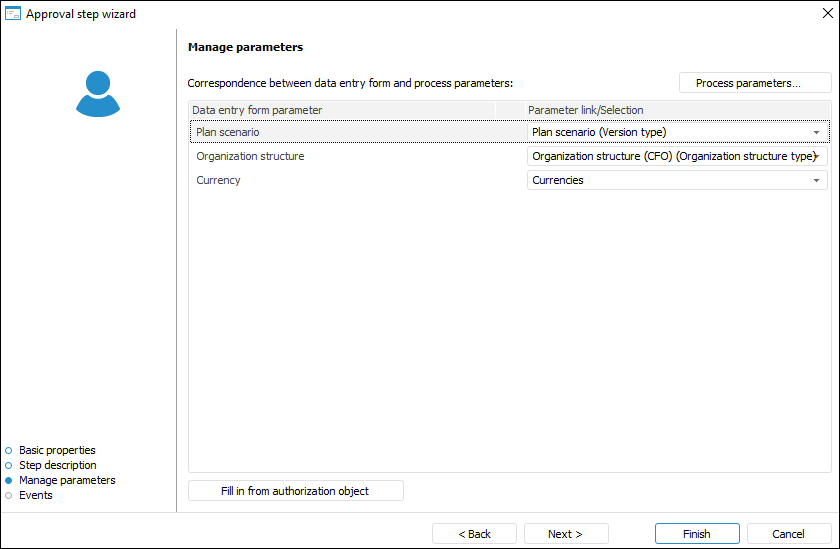
Determine the following for the Approval step on the Manage Parameters page:
Determine Correspondence Between Data Entry Form and Process Parameters on the Manage Parameters page:
To automatically copy parameter settings from authorization objects, click the Fill from Authorization Object button.
To manually set correspondence in the Parameter Link/Selection column, select the checkbox:
Undefined. In this case the data entry form or report opens with parameter value specified in the default data entry form or report:

Bind. In this case the process parameter corresponding to data entry form or report parameter is selected:
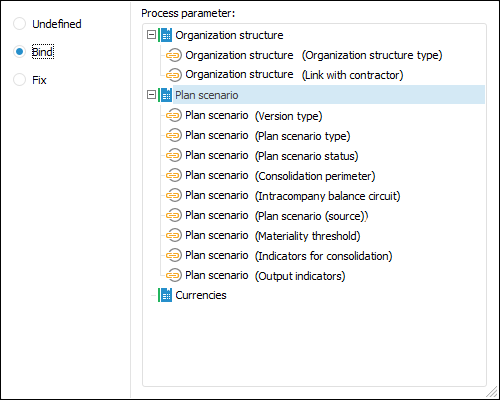
Select the dictionary attribute to be sent as a parameter to data entry form or report if required.
Fix. In this case, the specified values are selected in the drop-down list to send a limited number of parameter values to data entry form or report:
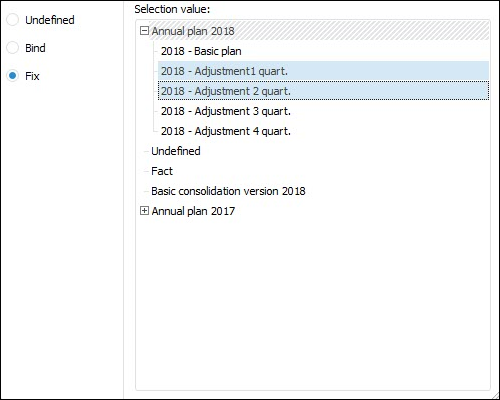
If there is no required process parameter, click the Process Parameters button. The Process Settings and Parameters dialog box opens where process parameter can be added.
After the parameters have been determined on the Manage Parameters page, click the Next button.
Setting Up Events Executed on Step Execution Start or End
Set up actions executed automatically on step execution start or end:
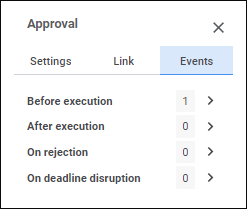
To create a list of executed operations:
Select the configured event on the parameters panel on the Events tab. The following events are available:
Before Execution. The list of actions will be started before executing the current step in the specified order.
After Execution. The list of actions will be started after executing the current step in the specified order.
On Rejection. The list of actions will be started on the current step rejection. The list is available for steps with manual execution. If the step is executed automatically, the tab is not displayed.
On Deadline Disruption. The list of actions will be started on deadline disruption to execute the current step in the specified order. To execute the actions:
When the server execution of processes is selected, select the Check Deadline Disruption of Steps checkbox on the Scheduler page and set check frequency.
When the client execution of processes is selected, select the Check Deadline Disruption item on the Administration page.
Click the
 Add button on the toolbar and select the added action:
Add button on the toolbar and select the added action:
 Fore Method. Fill in mandatory boxes highlighted with rose:
Fore Method. Fill in mandatory boxes highlighted with rose:Execution. Set execution time before/after deadline disruption. To do this:
NOTE. Execution time can be set only for the On Deadline Disruption event.
Select action execution type in the drop-down list:
Before. The action will be executed in the specified time interval before deadline disruption. It is set by default.
After. The action will be executed after the specified time interval after deadline disruption.
Specify the time interval. The default value is 0.
Select measurement units in the drop-down list. The list contains the values: Minute, Hour, Day, Week, Month. The Minute value is set by default.
Assembly. The box is mandatory. In the drop-down list select a Fore unit, the list contains all repository units and folders containing units. Search by unit name is available.
Method. The box is mandatory. Select a method in the drop-down list. The list contains all unit methods corresponding to the signature:
Sub <Fore-method name>(Sender: IBProcessInstance; Args: IBProcessStepStateEventArgs);
Parameter:
Sender. Process instance.
Args. Event information: step, step old state, new state.
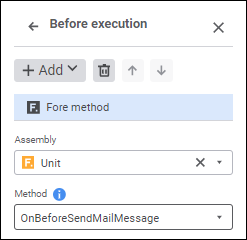
 Message. Set message parameters:
Message. Set message parameters:Execution. Set execute time before or after deadline disruption. To do this:
NOTE. Execution time can be set only for the On Deadline Disruption event.
Select the action execution type in the drop-down list:
Before. The action will be executed in the specified time interval before deadline disruption. It is set by default.
After. The action will be executed after the specified time interval after deadline disruption.
Specify the time interval. The default value is 0.
Select measurement units in the drop-down list. The list contains the values: Minute, Hour, Day, Week, Month. The Minute value is set by default.
To. Enter one or several main recipient addresses separated by the ; character. The box is mandatory.
Copy. Enter address of one or several recipients separated by the ; character.
BCC. Enter address of one or several recipients separated by the ; character. Address will be hidden from other message recipients.
Subject. Enter message subject.
Object Link. Add a link to the step object in the drop-down list: algorithm, regular report, data entry form. Multiple selection is available.
When an object is selected, the web application URL is inserted in the Subject box as follows: http://app_name/#/app/obj?key=<obj_key>&mode=view&repo=<repo_id>», where app_name - name of opened web application, repo_id - identifier of the current repository, obj_key - key of the selected object.
Message. Enter message text.
Attached File. Attach files to the message. Each attached file is displayed below the edit box. To remove the file, click the
 Remove button to the right of the attached file name.
Remove button to the right of the attached file name.
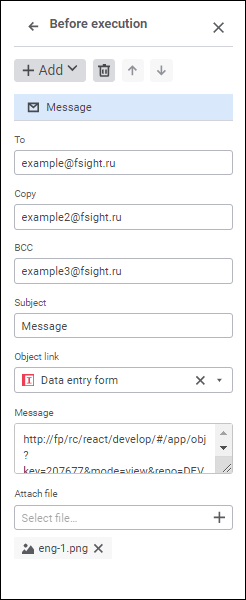
NOTE. The number of added actions is unlimited.
To change the order of executed actions, use the  Move Up and
Move Up and  Move Down buttons on the toolbar on the Events tab; to delete, use the
Move Down buttons on the toolbar on the Events tab; to delete, use the  Delete button.
Delete button.
The list of automatically executed actions can be empty.
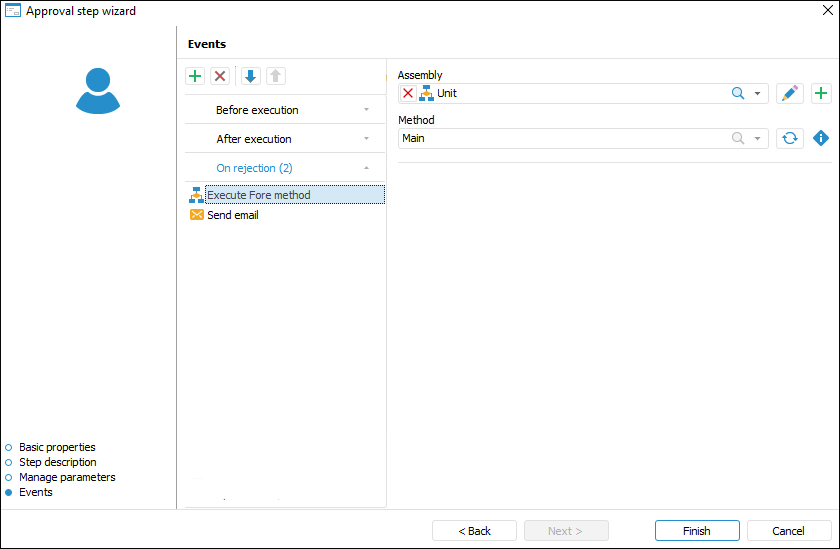
To create a list of executed operations:
Select the tab with the configured event on the Events wizard page. The following events are available:
Before Execution. The list of actions will be started before executing the current step in the specified order.
After Execution. The list of actions will be started after executing the current step in the specified order.
On Rejection. The list of actions will be started on the current step rejection. The list is available for steps with manual execution. If the step is executed automatically, the tab is not displayed.
On Deadline Disruption. The list of actions will be started on deadline disruption to execute the current step in the specified order. To execute the actions:
When the server execution of processes is selected, select the Check Deadline Disruption of Steps checkbox on the Scheduler page and set check frequency.
When the client execution of processes is selected, select the Check Deadline Disruption item on the Administration page.
Click the
 Add button on the toolbar and select the added action:
Add button on the toolbar and select the added action:
 Execute Fore Method. Determine:
Execute Fore Method. Determine:Unit. In the drop-down list select a unit written in the Fore language, the list contains all repository units and folders containing units. Search by unit name is available.
To edit the selected unit, click the  Edit button.
Edit button.
To create a unit, click the  Add button.
Add button.
Method. Select method in the drop-down list. The list contains all unit methods corresponding to the signature:
Sub <Fore-method name>(Sender: IBProcessInstance; Args: IBProcessStepStateEventArgs);
Parameter:
Sender. Process instance.
Args. Event information: step, step old state, new state.
To refresh the methods list, click the  Refresh List button.
Refresh List button.
To copy method signature, click the  Copy Signature button.
Copy Signature button.
 Send Email. Set message parameters:
Send Email. Set message parameters:To. Enter one or several main recipient addresses separated by the ; character. The box is mandatory.
Copy. Enter address of one or several recipients separated by the ; character.
BCC. Enter address of one or several recipients separated by the ; character. Address will be hidden from other message recipients.
Subject. Enter message subject.
Contents. Enter message contents using the option of variables values substitution with step parameters, links to step objects to view in the web application, file attachments.
NOTE. The number of added actions is unlimited.
To change the order of executed actions, use the  Move Up and
Move Up and  Move Down buttons on the toolbar of the Events wizard; to delete, click the
Move Down buttons on the toolbar of the Events wizard; to delete, click the  Delete button.
Delete button.
The list of automatically executed actions can be empty.
To determine parameters on the Events page, click the Finish button.
Click the Finish button to exit the wizard.
After creating the process steps, set up steps execution conditions.

 Open the wizard
Open the wizard